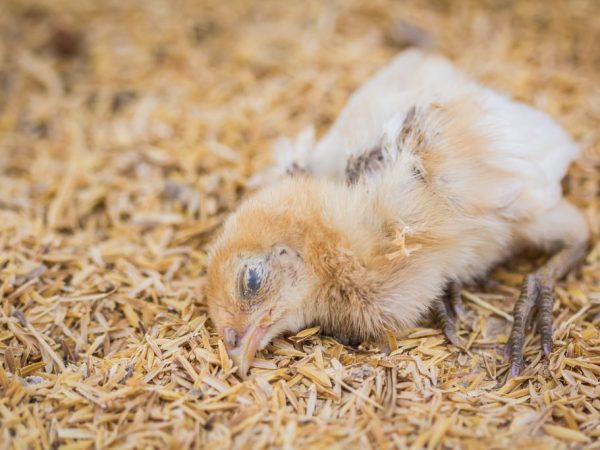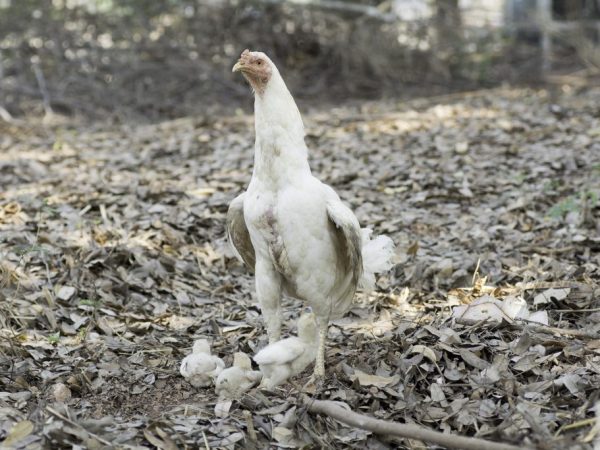Treatment of coccidiosis in chickens
Coccidiosis is a common disease in chickens. It appears mainly at an early age and is associated with a weakened immune system. In 80% of cases, this is fatal. More often it is epidemic in nature, manifesting itself sharply and in a short period of time spreading to all livestock. It is treated with medication. As an additional measure, alternative methods are applicable.

Treatment of coccidiosis in chickens
Etymology of infection
The causative agent of coccidiosis is the parasitic pathogenic unicellular bacterium Eimeria, which lives on foliage and in the soil.
In total, there are about 11 types of parasites that can cause an infectious disease.
Solitary specimens are present in the body of the bird, the infection proceeds without visible symptoms, especially in layers, and does not pose a danger.
However, with a large accumulation and weak immunity, they lead to disastrous consequences.
When pathogens enter, active reproduction and damage to the stomach and intestines occur.
The pathogen settles in the cecum and subsequently spreads to the small intestine. Resistant to disinfection and low temperatures. Dies in case of complete drought and heating of the environment.
The severity of the disease depends on the localization of the bacteria, the intensity of its reproduction, the quality of metabolic processes in the bird and the strength of the immune system.
The risk group for coccidiosis is youngsters aged 2 weeks to 3 months, whose immune system has not yet sufficiently strengthened.
The life cycle of a pathogen is 4-27 days, while the developmental stage is finite, and individuals who have undergone infection in some cases recover on their own, without treatment.
Signs of infection
Symptoms of coccidiosis in chickens:
- violation and loss of appetite, refusal of any type of feed;
- frequent drinking;
- lethargic state with coughing, constriction and closing of eyes;
- diarrhea with frothy discharge and bloody clots;
- the presence of mucus in the beak;
- lack of response to irritating factors.
The most accurate diagnosis is made on the basis of laboratory studies of droppings and scrapings from the intestinal mucosa, because coccidiosis is often confused with borreliosis, trichomoniasis, pullorosis due to the similarity of external symptoms.
When the first symptoms are found, the diseased bird is transplanted into an isolated cage.
With the multiplication of pathogenic bacteria and their destructive effect on the internal organs of chickens, the ability to eat well is lost, because the digestive system cannot cope with the ingested food, nutrients are not absorbed.
As a result, they rapidly lose weight, the skin becomes blue due to the onset of anemia, convulsions and paralysis are noticed.
Without the timely appointment of medication, this condition of poultry is fatal.
Causes and contributing factors
The source of infection is parasites, the larvae enter with food on free range or are formed when kept in cramped conditions and high humidity.
They also penetrate dirty drinking water, contaminated feed, shells, bedding and droppings.
The pathogen is spread by insects and rodents, a person spreads the infection with overalls and technical equipment.
Drug treatment

Treatment should be started urgently.
Treatment of coccidiosis, especially in an acute form for no longer than 4 days, is required immediately after the first signs of infection are detected.
Early treatment increases the chances of recovery from infected chicks, adult layers and broilers.
Coccidiostatics
During treatment, the use of coccidiostatics of different groups is allowed:
- preventing the development of resistance to re-infestation, applicable to birds planned for slaughter;
- aimed at the formation of immunity, suitable for breeding farms where it is important to keep the livestock.
They are more often used to treat broiler chickens. They are sent to slaughter at the age of 2-3 months, therefore, therapy with other drugs is not carried out.
The dosage of drugs of the first group is taken as a percentage of the mass of feed:
- pharmacokcid - 0.0125;
- kayden stenerol - 25.0 0.05;
- rehycoccin - 0.01;
- perbeck - 0.05;
- Khimkokcid - 0.0035.
The use of funds is stopped 3-5 days before the scheduled date of slaughter.
For breeding broiler chickens, a medicine of the second group is used:
- aprolium - 0.0125% within 7-10 weeks;
- coccidiovitis - 0.1%;
- ardilon - 0.12%;
- coccidin -0.0125%;
- iramine - 0.4% for 10 days with an interval of 3 days.
In order to avoid the addiction of the pathogen to active substances, the drugs are alternated.
Antibiotics
Together with coccidiostatics, antibiotics of a wide range of effects are prescribed. The dosage of the drug is calculated in the same way, as a percentage of the weight of the feed:
- monensin - 0.012;
- salinomycin - 0.06.
At the first signs of an infectious disease, medications used for humans are prescribed: chloramphenicol, metronidazole, erythromycin and trivit.
They need to be drunk in a course designed for 5 days (according to a certain scheme):
- Levomycetin 1 tab, trivit ½ tab per 1 liter of water;
- Erythromycin 1 tab, trivit ½ tab per 1 liter of water;
- Metronidazole 1 tablet, trivit ½ tablet per 1 liter of water;
- Levmitetin 1 tab, erythromycin 1 tab, trivit ½ tab per 1 liter of water;
- Erythromycin 1 tab, metronidazole 1 tab, trivit ½ tab. for 1 liter of water.
This dosage is calculated for a herd of 10 individuals.
Antibiotics are replaced with antibacterial drugs in breeding farms, where the rearing of layers is aimed at obtaining eggs:
- sulfadimethoxine - 0.01% courses for 5 days with breaks of 15.20 and 35 days;
- sulfadimezin - 0.2% courses for 3 days with a break of 2 days until complete recovery.
Probiotics
For complex treatment, probiotics are prescribed to help restore the functioning of the affected intestine:
- olin - 40-100 g per 100 kg of feed, not earlier than 2 hours after taking the antibiotic;
- zoonorm - a course of up to 5 days, the dosage is selected depending on the age of the bird.
Traditional methods
Alternative methods of treating coccidiosis of chickens are an additional measure and are based on the extremity of the development cycle of eimeria, suggesting that an infected individual can recover without re-infection.
Their main task is to create favorable conditions for cure and prevent the spread of infection in the livestock.
- Iodine. Make a solution with a concentration of 0.01%. 2 ml are soldered daily, starting from the first days of life until the age of 40 days, then the dose is increased to 5 ml until the age of 60 days.
- Sulfur. Every day for 2 weeks, add to the feed at the rate of 2% of its weight.
Consequences of the transferred infection
The danger of coccidiosis lies in a decrease in immunity to other diseases.
Due to the active multiplication of bacteria in the intestine and their violation of the integrity of the mucous membranes, colibacillosis, clostridiosis, salmonellosis and other bacterial ailments join the disease.
With recovery, the work of the internal organs of recovered individuals is normalized.
After treatment with drugs from the antibiotic group, meat and eggs are not suitable for consumption for 2 weeks after the last drug intake.
Preventive measures
Preventive measures are aimed primarily at increasing the immunity of poultry, which is ensured by a full-fledged diet.
An additional means is the creation of optimal conditions for keeping, excluding the ingress of chicken droppings into the feeders and drinkers.
For this purpose, preference is given to cages with mesh floors and external feeding and drinking devices.
As a preventive measure, crushed yarrow and wormwood are added to the feed. They have medicinal properties and improve the digestion process.
Technical equipment is subject to systematic cleaning and disinfection. The instruments are disinfected by firing with a blowtorch fire.
It is much more difficult to provide effective prevention of coccidiosis in a private household, because chickens are more often on the street.
Livestock are given coccidiostatics (in agreement with the veterinarian) in a dosage that is less than it is required to treat the infection. In this case, medications can be replaced with ready-made premixes, which include active medicinal components.
Ionophores are actively used, which have a mild effect and have a cumulative effect:
- nikarbazin - mixed with feed at the rate of 0.5 kg per 1 ton, given throughout the entire period of rearing the young, stop 5 days before slaughter;
- robenidin - 33 g per 1 ton of feed, from the moment of birth, stop 5 days before slaughter;
- zoalen - 0.125 g for each kg of feed, duration - 2 months.
Ionophores of the Hewepharma company, produced in microgranular form and used by manufacturers in the production of premixes, are gaining great popularity.
For prophylaxis in areas unfavorable for coccidiosis, vaccinations are made, feeding a given, but safe amount of eimeria in order to form immunity to the pathogen.
Chickens are vaccinated starting from the 9th day of life. The most popular is the Aviox vaccine for oral administration through food or drink.

